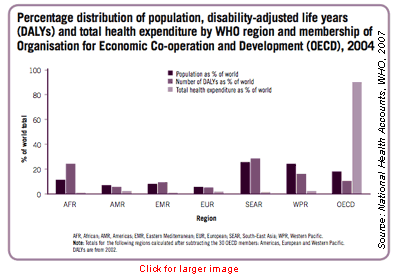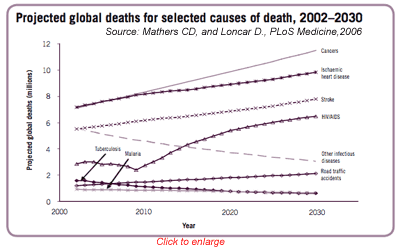Center for Communications, Health and the Environment

Health Budgets Affect Global Disease Burden, Life Expectancy
In 2004, the world spent a total of Intl $4.9 trillion on health. But the geographical distribution of these financial resources was uneven, and it continues to remain so, according to the World Health Organization's National Health Accounts (http://www.who.int/nha). *
In fact, a mere 30 countries spend 90 percent of the world's health resources. Even more telling is that these countries – all members of the Organisation for Economic Co-operation and Development (OECD) – comprise less than 20 percent of the world's population.
Including countries such as Australia, Japan , most Western European nations, Canada and the United States, OECD countries spend an average of 11 percent of their gross domestic product (GDP) on health. This is a significantly larger share than other nations, including those in WHO's African and South-East Asia regions, where health expenditures average only 4.7 percent of GDP. Such percentages translate into per capita spending on health of about Intl $3,080 in OECD countries compared with Intl $102 in countries in the African and South-East Asia regions, which are much poorer. **
Linking this spending to epidemiology, WHO data show that:
- Poorer regions, such as Africa and South-East Asia, comprise 37 percent of the world's population and account for the largest share of the global disease burden, with more than 50 percent of global disability-adjusted life years lost, but spend only about 2 percent of the world's health resources.
- The Western Pacific Region, excluding Australia, Japan, New Zealand and the Republic of Korea, accounts for 24 percent of the world's population (dominated by China) and about 18 percent of the global burden of disease, but only another 2 percent of the world's health resources.
- The Region of the Americas and the European Region, excluding the OECD countries, account for about 12 percent of the world's population and 11 percent of the global burden of disease, and spend slightly less than 5 percent of all global health resources. [Read Full Lead Article]
Shifts in Global Disease, Death Linked to Lifestyle, Income
In 2004, the world spent a total of Intl $4.9 trillion on health. But the geographical distribution of these financial resources was uneven, and it continues to remain so, according to the World Health Organization's National In the recently published World Health Statistics 2007, the World Health Organization (WHO) projects that the world will experience a substantial shift in the proportion of deaths from communicable to noncommunicable diseases (and from younger to older age groups) during the next 25 years. Thanks to medical advances and widespread vaccination programs, large declines in mortality have already occurred and are anticipated to continue between now and 2030 for all principal communicable, maternal, perinatal and nutritional causes. The only exception to this is HIV/AIDS, global deaths from which are expected to more than double, despite increased awareness and antiretroviral drug coverage.
In addition to HIV/AIDS, the leading causes of death globally in 2030 are projected to be noncommunicable conditions: ischaemic heart disease, cerebrovascular disease (stroke) and chronic obstructive pulmonary disease. Cancers will top the list, accounting for a projected 11+ million global deaths (see chart). Overall, noncommunicable diseases will comprise almost 70 percent of all deaths in 2030 under the baseline scenario, spurred by urbanization, increasingly sedentary lifestyles and the graying of the global population.
Meanwhile, the total number of tobacco-attributable deaths is projected to rise from 5.4 million in 2005 to 6.4 million in 2015 to 8.3 million in 2030. Tobacco is expected to kill 50 percent more people in 2015 than HIV/AIDS and to be responsible for 10 percent of all deaths worldwide. [Read Full Companion Article]

Dr. Sushma Palmer, Program Director
Valeska Stupak, Editorial & Design Consultant
Shiraz Mahyera, Systems Manager
Rohit Tote, Website Consultant
